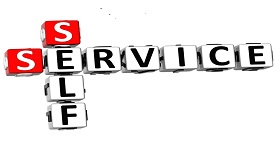There is some truth behind the adage “you only get one chance to make a first impression,” and when it comes to customer service, there is no room for mistakes with the initial point of contact. Today’s customer knows how to get what they want, and often times will seek out ways to service themselves before reaching out to an agent. This is when having the right tools in the self-service tool box can be how you differentiate from your competition.
Self-service is a feature, or features, that allow customers to manage services themselves, without involving the service provider. This is done by way of the Web in the form of an FAQ page, apps, self-checkout, and yes, even IVR. How important is self-service to customers? Let’s look at some statistics: the Real Self-Service Economy surveyed approximately 3,000 consumers, and 40 percent of the respondents said they prefer self-service to human contact for their future contact with companies; a whopping 70 percent expect a company website to include a self-service application.
This is especially true for the current generation of customers; millenials and Gen X consumers often take to the Internet before picking up the phone to talk to a live agent. Given that, how can businesses offer self-service options that are easy to use, provide what the customer needs, and ensure a positive experience over all?
It’s imperative that companies factor in the customer’s needs and wants into crafting the right self-service point of contact because the customer is the single most important component of the self-service process. Once you have a good idea of what self-service will look like for your customers, it’s important to start getting the pieces in place to turn this vision into a reality.
 Image via Shutterstock
Image via Shutterstock
Will you use IVR? If so, then writing a properly scripted IVR menu leads customers to the answer they need, provides them with the opportunity to navigate to a live agent, and decreases the overall call volume that reaches your call center. Is your FAQ on your website up to date? Perhaps you’ve received calls asking the same questions over and over again. If this is the case, use these to offer the information right to the customer online, which can eliminate the need for calling into customer service.
Maybe your customer prefers to talk with other customers, and if offering an online community can help bring customers together, it’s considered another win in the self-service department. Companies of any size can use shared environments over the Internet to open lines of communication with their customers in a mutually beneficial way.
Ultimately a self-service portal should empower end users to request services, find information, and log and resolve their own issues. Essentially, the end user becomes the first line of support, and that can be a positive foray into the first line of contact. With self-service, there’s no waiting for an agent pick up the phone. There’s less frustration and more time to get on with their needs.
The self-service model gives the customer the power, and for many, this is a powerful tool for the first line of contact.
 Internet Telephony Magazine
Click here to read latest issue
Internet Telephony Magazine
Click here to read latest issue CUSTOMER
CUSTOMER  Cloud Computing Magazine
Click here to read latest issue
Cloud Computing Magazine
Click here to read latest issue IoT EVOLUTION MAGAZINE
IoT EVOLUTION MAGAZINE




